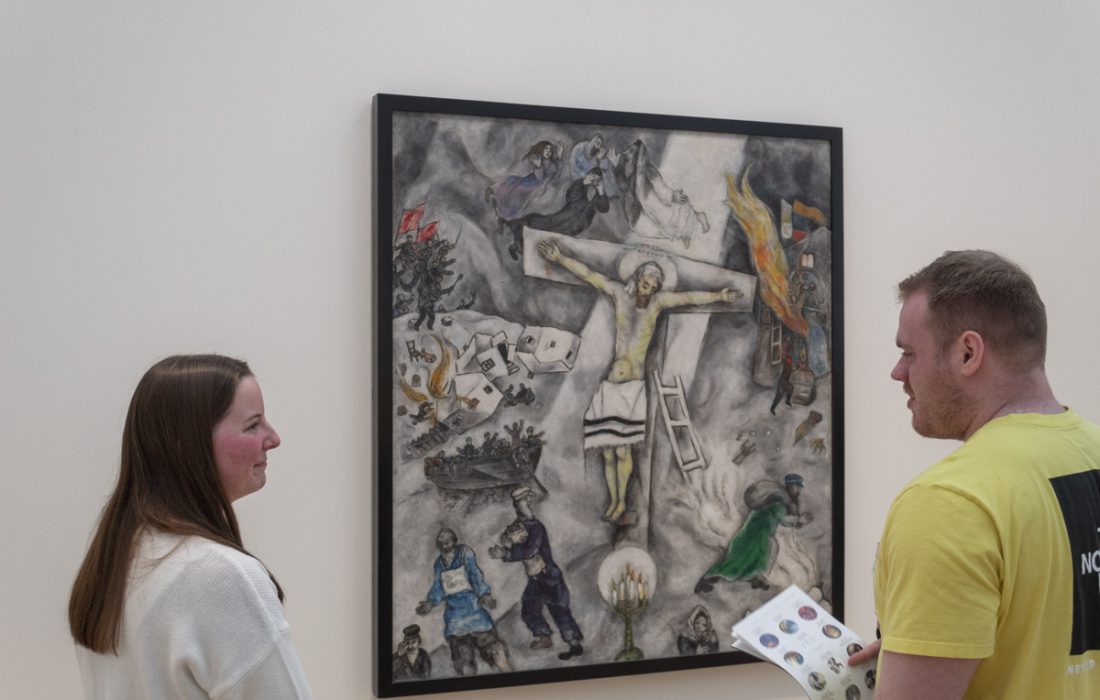Writer Hailey Gates talks about using fine art to view the world.
Essay: Fine Art as a Frame of Reference
I first saw the world as a painting last February. I was in New York City, riding in a taxi from LaGuardia Airport to Manhattan and looking out at the skyline that loomed in the distance — an impenetrable force rising out of the water below.
As the car dove under the East River and came up into Manhattan, I noticed the city lights unfold around me — the skyline had dissipated into a rich multifaceted world, a series of separate points, individual yet integral to the greater image.
The world can be better understood when looked at in relation to the art it has inspired. Art is an informant, a reflection of the profoundly human at a slightly different angle. This is this relatability that keeps fine art relevant. Paintings work as a magnifying glass or a kaleidoscope — they provide a lens to see the world through.
The experience of driving into Manhattan reminded me immediately of Georges Seurat’s 1884 “Sunday on La Grande Jatte.” From a distance, New York City is holistic. But upon moving closer to its heart, one is thrust into its distinct aspects, each detail so profoundly necessary that the accompanying feeling is not unlike being lost in Seurat’s pointillism.
It was liberating to realize I was another one of the dots making up the New York skyline.
There was something significant about the dynamic between reality and art. In viewing myself as part of the picture, I was meeting Seurat in the feeling of New York.
Ever since that moment, fine art has cropped up incessantly in the outskirts of my world. Art works to synthesize — seeing what’s around me through someone else’s eyes helps me characterize what I see through my own. It’s a reflection of the self in a representation of the other.
Using art in this way is essential. It helps guide my perception of myself as a part of everything around me.
When I look around downtown Chicago, I see Archibald John Motley Jr. ‘s “Nightlife.” The potential of the piece is all in the movement. It represents the promise of adventure in a vibrant and bustling city, the ever-present possibility of meeting someone new. To me, it’s indicative of the undergraduate journey — an homage to collective experience.
It’s not just grandiose cities that reflect fine art — I see paintings even in the minutiae of my particular life. Dorm-living is evocative of Ed Hopper’s “Nighthawks,” an exploration of privacy as the viewer stares at the subjects through the window of a diner. Every night, looking out my apartment window and unintentionally into the lives of my neighbors, I am struck by the relevance of Hopper’s work. Fine art may seem displaced or esoteric, but it is fundamentally rooted in everyday life. Art is inherent.
The art I see is ever-present and ever-changing. As I walk around campus, it shifts in tandem with the situation or the object. Lake Michigan, for example, conjures almost an infinite amount of images — at dawn, I see the graceful serenity of Georgia O’Keefe’s “Sky Above Clouds IV” in the sun’s soft light and the water’s chilly breeze.
At night, walking along the lake, the melancholic moon and gentle waves remind me of Katsushika Hokusai’s “Kohada Koheiji, from the series ‘One Hundred Ghost Tales (Hyaku monogatari),’” the skull in the image looking down solemnly like the planes soaring over the flattened-out oblivion.
I see everything in paintings. They’re fragments of others’ perceptions of the world. It’s an anachronistic conversation, a seemingly impossible mutuality brought to fruition by the human experience.
This is the point of fine art — the relevance of it. It’s the corporeal, cross-historical, unintentional recreation of scenes that have at once altered and permeated throughout time. The feelings and experiences captured by artists of years past maintain their relevance in the viewer’s ability to relate to them and in their unbidden application to everyday life.
An image conjured by another makes clearer what is right in front of me. Art imitates life in its creation but as works of art persevere through time, it’s life that begins to imitate art.
It’s necessary to continue to see art in the world around us, to better understand ourselves in relation to it and to better appreciate its extensive beauty. I will continue to look around and embrace the image when it comes, to soak in every detail of the life and art around me.
When I do this, I see myself as the woman in Jules Adolphe Breton’s “The Song of The Lark.” I look outside of myself and into the world as the light deepens everything around me, just like the crimson sun rising in the painting.
Feature Image by Hunter Minné
-

Hailey Gates is a third-year student majoring in English and minoring in journalism and art history. In addition to working as Opinion Editor of The Phoenix, she is a Writing Fellow at the Writing Center and a Provost Fellow undergraduate researcher. She loves to write feature stories about local art and artists and Opinion pieces on everything from national politics to Reese’s Peanut Butter Pumpkins.
View all posts
Topics
Get the Loyola Phoenix newsletter straight to your inbox!


